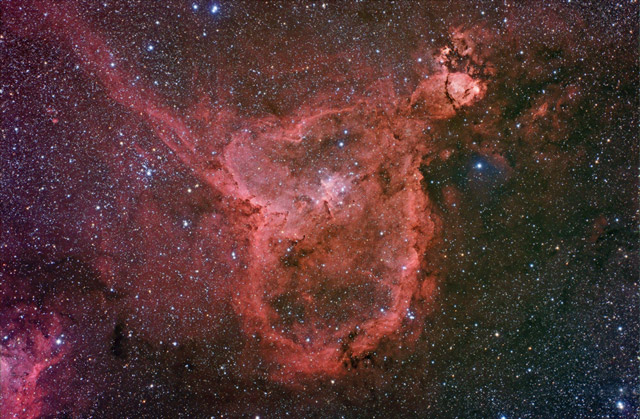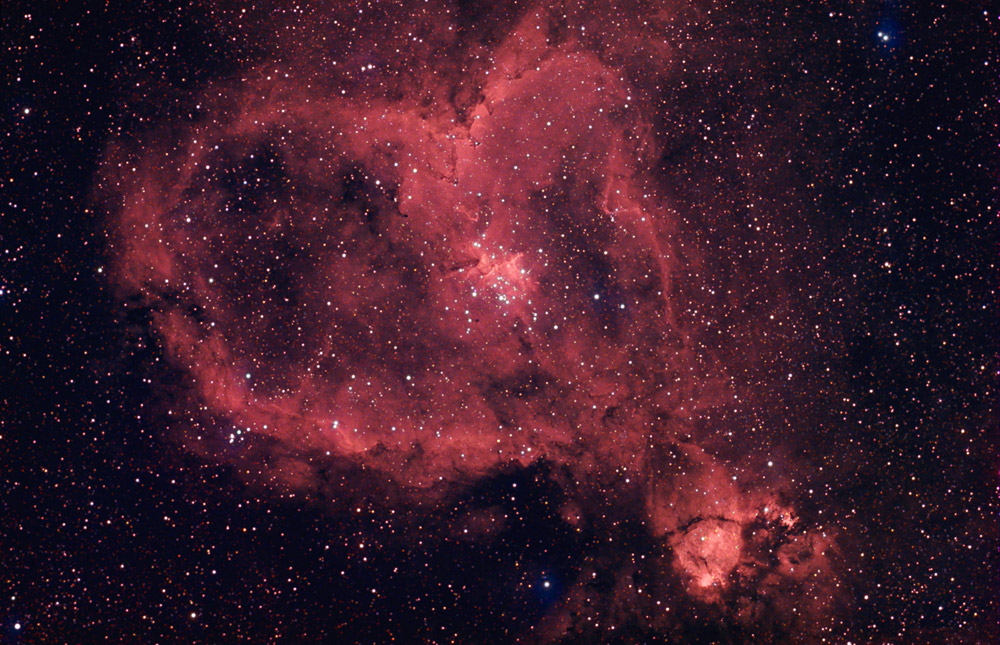| Time Travel Research Center © 2005 Cetin BAL - GSM:+90 05366063183 - Turkey / Denizli | ||||
|
|
||||
|
IC 1805
|
|||
|
CASSIOPEIA - EMISSION NEBULA |
||||

IC
1805 - The Heart Nebula in Cassiopeia
|
About this Object: |
|
Cassiopeia is an astrophotographer's dream! It is filled with shapely, beautiful emission nebulae. This image portrays one of the most spectacular of those nebulae, and perhaps one of the most unique objects in the night sky. Located next to another emission nebula, IC 1848 (click here for image), the two together comprise the Heart and Soul Nebula complex. This complex happens to be to very close to another grand site, the Double Cluster in Perseus. IC 1805 is the name for the large, heart-shaped area of nebulosity, but many of the components of this image have other designations. At the very center of the "heart" is an open cluster of stars known as Melotte 15. This cluster can be seen with just about any telescope as a couple of dozen stars, quite indistinct. The two bright patches at the bottom are known separately as NGC 896 and IC 1795, from left to right respectively. At the left side of IC1805 is a line of stars known as Markarian 6. To observe the nebulosity itself, you must have large apertures (over 16") and either UHC or OIII filters. With such a setup, you should see NGC 896 as a faint glow, and perhaps even part of the arc of IC1805 itself. Averted vision might be the only way to see it, and I shouldn't have to say it, but you'll also need dark skies. Even though this object might not be too pleasing through a scope, it certainly is with a camera. To enhance the detail in the object, I employed a technique whereby I used a special filter that captures the Hydrogen Alpha emissions of the nebula, took parts of the image through it, and then used that information to give the image a special luminance component. It is a difficult technique to perform from a processing standpoint, but I'm quite pleased with the result, which is a good thing, since this nebula deserves a place in everyone's heart (pun intended). |
Location:
Eldorado Star Party,
Eldorado, Texas
Date: October 20, 2006
Seeing:
4/10
Transparency: 6/10
Temperature: -25 degrees C on camera
Scope/Mount: Tak FSQ-106 @ f/5 on Paramount ME
Camera: SBIG STL-11000M astro CCD camera
Filter: Custom Scientific 4.5 nm H-alpha filter
Exposure Info: HaRGB image; 160:50:30:60 minutes (10 minute
subexposures for RGB, 20 minute subexposures for Ha)
Processing
Information:
Acquisition with CCDSoft.
Calibration (darks/flats), and registration in CCDstack (median combine).
LRGB combine and Ha blending, color balance, levels/curves, and noise
removal/local contrast enhancement (Noel Carboni's Astronomy Tools) in
Photoshop CS.
Previous Images:

Click on the image for larger resolution (1600 x 1032 pixels)
Location:
The Ballauer Observatory near Azle, Texas
Date: September 8, 2004
Temperature: 60 degrees F
Seeing: 8/10, steady
Transparency: 8/10
Scope/mount: Takahashi FSQ-106 @ f/5 and Tak NJP mount
Camera: SBIG STL-6303E, self-guided
Filter: Custom Scientific 4.5 nm Hydrogen Alpha
Exposure Info: HaRGB image - 150:20:20:20 minutes (15 min.
subexposures for luminance; 5 min. subexposures for RGB, binned 2x2).
Processing Info: Dark frame calibration, flat-fields, de-blooming,
registration, and average combine of all channels in MaxIm 4.0. Digital-Development
in MaxIm. Blending of final data, Levels, Curves, Unsharp mask, Despeckle,
and color balance in Photoshop CS.
Extra notes: The red channel is blended 50/50 with the Ha
luminance. Full luminance used on final combine. Special thanks to Three
Rivers Foundation (3RF) for the use of some of the equipment used in
creating this image.
Astronomi Nebula Resimler Astrophotography Galaxy Resimler Yıldız Resimler
Copyright(c) 2003 - 2006 Cetinbal - All rights reserved.